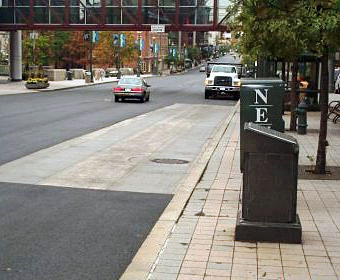Curbs and Gutters
Concrete and Other Materials
Advantages | Types | Requirements | Design | AASHTO Standards | Joints | Drainage | Materials | Construction
Specifications should call for concrete meeting the requirements of the local transportation agency or ASTM C 94, with appropriate qualifications for strength, aggregate size, slump, and entrained air. ASTM C 94 covers concrete manufacturing, delivery, and quality control. By reference, ASTM C 94 incorporates the ASTM standards for concrete ingredients and quality control tests. Ordering concrete produced by a plant currently certified by the NRMCA Ready Mixed Plant Certification Program can provide assurance that the supplier is capable of producing and delivering quality concrete. ACI 211.1, "Standard Practice for Selecting Proportions for Normal, Heavyweight and Mass Concrete" can be useful in selecting concrete mixture proportions. The use of standard specifications of the local transportation agency can be advantageous where materials suppliers are familiar with them and routinely deliver quality concrete to meet them.
 In areas with mild exposure, specifications may require concrete with a 28-day compressive strength of only 3,000-psi or the concrete quality may be dictated by proportioning to allow efficient slipforming without slumping. Slipforming necessarily limits the amount of water that can be used in mix and the slipform process requires cementitious materials and aggregate combinations that will produce smooth surfaces without handwork for closing voids.
In areas with mild exposure, specifications may require concrete with a 28-day compressive strength of only 3,000-psi or the concrete quality may be dictated by proportioning to allow efficient slipforming without slumping. Slipforming necessarily limits the amount of water that can be used in mix and the slipform process requires cementitious materials and aggregate combinations that will produce smooth surfaces without handwork for closing voids.
In areas with severe exposure, specifications may require a 28-day compressive strength of at least 4,500-psi for durability. The concrete must be air entrained and have a high quality cementitious paste to survive many freeze-thaw cycles and applications of deicer salts. It should have at least 5% entrained air, with a maximum allowable of 8%. Some designers consider 4,000-psi concrete to have adequate durability for exterior use, but a higher requirement for 28-day compressive strength is suggested because of the extremely harsh conditions curbs must endure. Local availability and construction methods will determine top size coarse aggregate, but 3/4 in. top size is commonly used. Smaller coarse aggregates will require additional water in concrete and should be avoided if possible. Required consistency of the concrete will depend on construction methods. Whether shaped by hand or by slipform machine, the concrete may have to stand by itself, and therefore high slumps are not acceptable. In any case, concrete should be placed with the lowest amount of water that will provide workability and finishability. Proper combined aggregate gradations are important to achieve workability with lower water contents that enhance strength and durability.
The severity of exposure is defined in ACI 211.1. Concrete is in mild exposure area if the concrete is not exposed to freezing or to deicing salts. Concrete is air entrained to improve workability rather than durability. Concrete is in moderate exposure area if freezing temperatures are expected but the concrete will not be saturated for extended periods prior to freezing, and will not be exposed to deicing salts. Concrete is in severe exposure area if concrete will be exposed to deicing salts, or where concrete will be in contact with water and will potentially be saturated prior to freezing.
Silica fume, an extremely fine pozzolan that reduces permeability and increases strength, fly ash or slag are becoming popular constituents of concrete that must be durable in extremely harsh situations.
Reinforcing steel used as tie bars or longitudinal reinforcing should comply with ASTM A615. Membrane forming curing compounds should comply with ASTM C 309, and isolation joint material should meet ASTM D 994, D 1751, or D 1752.


